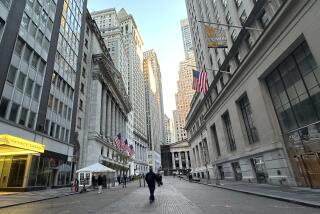Upcoming reports could calm — or validate — recession fears
- Share via
Reporting from Los Angeles and New York — The stock market’s wild ride last week showed just how jittery investors are about the threat of another recession.
A series of economic reports coming out in the days and weeks ahead could calm their fears — or confirm their worst suspicions. Economists and investors alike will scrutinize unemployment claims, retail sales and consumer confidence numbers like a doctor watching an ailing patient’s vital signs.
On tap for Tuesday: government reports on housing starts and industrial production for July, and second-quarter earnings from retail bellwether Walmart Stores Inc. And later this month, Wall Street will be closely focused on consumer confidence, manufacturing activity and an updated estimate of gross domestic product for the second quarter.
With the economy still ailing, any bad numbers could be amplified by big institutional investors ready to push the sell button at the first hint of trouble.
“Right now, given the nervousness of the market, everyone is putting every data point under a microscope,” said David Shulman, senior economist at the UCLA Anderson Forecast, who pegs the odds of another recession in the next 12 months at 25% to 30%. “There’s an extra premium in reading the tea leaves, whereas normally at this stage of the cycle, you wouldn’t be so worried.”
On Monday, at least, investors were more focused on deals than fears of another downturn. Stocks rose for the third straight day, buoyed by acquisitions action including Google Inc.’s $12.5-billion purchase of Motorola Mobility.
Some investors also said they were buying stocks that looked cheap after the panicked selling of the last three weeks, fueled by a disappointing government report on the nation’s economic output and a downgrade of the U.S. credit rating by Standard & Poor’s.
The Dow Jones industrial average ended up 213.88 points, or 1.9%, at 11,482.90.
The broader Standard & Poor’s 500 index rose 25.68 points, or 2.2%, to 1,204.49. The Nasdaq composite index added 47.22 points, or 1.9%, to 2,555.20.
But those gains could be undone Tuesday if weekly sales numbers from the International Council of Shopping Centers and Walmart earnings disappoint.
“We’re going to be looking closely at the strength of the consumer,” Shulman said. “As long as retail sales are growing, we’re not going to have a recession.”
In May, Walmart reported that U.S. same-store sales — a key measure based on sales at stores open at least a year — fell in the first quarter of the year as consumers held onto their pocketbooks.
Numbers on housing starts and industrial production will also give clues as to how the economy is faring.
With Thursday comes another important number: weekly initial claims for unemployment insurance. The number varies widely, and is generally not considered reliable because it is revised each week. But last week, the number helped propel the Dow up 400 points, as investors reacted to the news that the initial number of weekly jobless claims had fallen below 400,000 for the first time since April.
“The economy’s at the brink, we’re all counting on the numbers to turn positive,” said Esmael Adibi, director of the A. Gary Anderson Center for Economic Research at Chapman University. “Three or four consistent bad numbers makes everybody nervous.”
With most numbers, economists will be looking at whether results come in above, below or near estimates. Numbers that come in consistently below what economists had predicted will cause more concern.
One of the biggest data releases comes Aug. 26, when the Bureau of Economic Analysis releases its revised estimates on the nation’s GDP for the second quarter.
On July 29, the bureau revised its estimate for first quarter GDP, saying that it grew just 0.4% between January and March, far below its original estimate. For the three months ended June 30, the economy grew just 1.3%. That started a long slide in the market, during which the Dow plunged more than 1,000 points. Another downward revision of GDP for April through June could prove debilitating, said Adibi, who is hoping the number will be revised upward. If not, he said, “that would really be a disaster.”
In the last week in August, the Conference Board releases consumer confidence numbers and the Institute for Supply Management releases manufacturing figures, both important indicators. Perhaps most important: employment figures released Sept. 2 will show whether employers added or shed jobs in August. The previous three months have produced lackluster employment figures, after strong job growth in the beginning of the year.
Sluggish manufacturing or bad jobs numbers will put the recovery strongly in doubt, said Robert Mellman, senior economist at JPMorgan Chase. The numbers in late August and early September will also indicate whether last week’s volatile stock market further damaged the fragile recovery.
“We know pretty well how the economy did through July. The question is whether the market decline that started July 27 is taking us down some more,” Mellman said.
A decline in employment numbers or a rise in initial jobless claims could indicate another recession is upon us, he said.
And then there’s always the specter of what we don’t know. Events such as the Japanese earthquake and tsunami March 11 threw a wrench into the recovery and were not on any economists’ calendars. Many economists drastically reduced their forecasts for the year because of the earthquake and the Standard & Poor’s downgrade of the nation’s credit rating, said Robert A. Dye, chief economist at Comerica Bank.
A fragile economy is more susceptible to these kind of events than a strong one, he said, and an unexpected event now could also be debilitating.
“When you’re flying closer to the treetops at a lower altitude, you’re more vulnerable to transient economic events,” he said. “It would take very little to push us into recession.”
More to Read
Inside the business of entertainment
The Wide Shot brings you news, analysis and insights on everything from streaming wars to production — and what it all means for the future.
You may occasionally receive promotional content from the Los Angeles Times.











